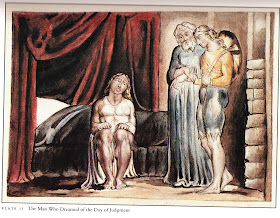The midpoint of the series of Blake's illustrations, the plate on which Pilgrim encounters Christ is preceded by the plate titled THE MAN WHO DREAMED OF A DAY OF JUDGMENT. So within the narrator's dream of Pilgrim's journey we find an encounter with another dreaming man - a dream within a dream - symbolic of descending to a deeper psychological level. It is at this level that it is possible that the burden which Christian has been bearing - the consciousness of sin - can be removed. In Blake as in Genesis, the division of reality into the categories of Good and Evil precipitates the divisions in man which constitute the 'fall'. The reversal of this consciousness (of sin) opens the way for the appearance of Christ and reunification.

This is plate 13 of Blake's illustrations to Bunyan's Pilgrim's Progress - THE MAN WHO DREAMED OF A DAY OF JUDGMENT.
The observer is Christian - the pilgrim with the burden of sin strapped to his back as it has been represented since Plate 2. Norvig sees the encounter represented in Plate 13 as bringing into consciousness the image of the Last Judgment as a scene of fear and punishment.
Encountering this dream content allows Pilgrim to move to the next scene - an encounter with the Christ and a release from the burden which he had been carrying. Just as the consciousness of sin had become an ever present burden to Pilgrim, the fear of punishment at judgment was acting as a detriment to encountering Christ.
In Gerda S.Norvig's book Dark Figures in the Desired Country: Blake's Illustrations to the Pilgrim's Progress she comments on Plate 13, THE MAN WHO DREAMED OF THE DAY OF JUDGMENT:
"From Bunyan's text we know that the man in this emblem is meant to he a warning to Christian, just as the subject of the previous illustration was. But there is a big difference in the mentality of the two characters, a difference Blake picks up on and generously amplifies to his own interpretive purpose. For although Bunyan's version of this emblematic dreamer-within-a dream shakes and trembles from his haunting fear that he is doomed, he is not so fixated or developed in his anxiety that he has lost all perspective on it. Unlike the man in the iron cage, he talks about his fear and about his vision. He thus creates a certain amount of figural and dialogic distance between himself and his feeling state figured in his dream. That is the saving grace, and indeed for Blake this figure from the Progress typifies the very possibility of a saving grace in everyone's psychic organization. Thus, despite the man's dream-vision that he will be rejected by God at the Last Day, he has two valuable attributes (themselves God-given) that help to counteract the implosive effects of his negative intuition: he has the visionary power to create a clear embodiment of his fear and the capacity to reflect consciously on its imaged content." (Page 164-5)
This is the crux of the issue as Norvig sees it: "It is as though the articulation of the damnation-fantasy held by the man dreaming of the Last Judgment in the House of the Interpreter released this contrary image of deliverance through his own visionary opening in obedience to an inner law of psychological compensation in the mind of the original dreamer."
Romans: 8:1-2 - No condemnation now hangs over the head of those who are "in" Jesus Christ. For the new spiritual principle of life "in" Christ lifts me out of the old vicious circle of sin and death.
Norvig: "It is the identification Christian himself makes between his [own] imaginative nature and Christ's resurrection that permits and denotes the falling away of the burden. Therefore, the burden in its death throes appropriately recalls the burial of Jesus, whereby a corruptible body was converted to an incorruptible. To enhance the hints Bunyan gives of this connection, Blake fashions the burden to look like an unborn human embryo crouched by the transept of the sepulcher's doorway. It also has the appearance of crumpled clothing, a possible allusion to the linen cloths found folded up beside Christ's tomb after the resurrection." (p 169)
The point of return has been achieved; challenges remain but the result is assured.
Jerusalem, PLATE 43 [29], E(191)
"Then the Divine Vision like a silent Sun appeard above
Albions dark rocks: setting behind the Gardens of Kensington
On Tyburns River, in clouds of blood: where was mild Zion Hills
Most ancient promontory, and in the Sun, a Human Form appeard
And thus the Voice Divine went forth upon the rocks of Albion"

No comments:
Post a Comment